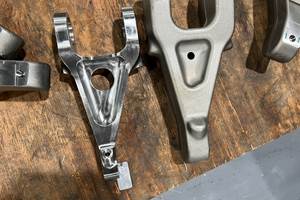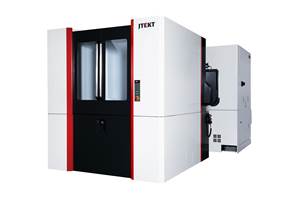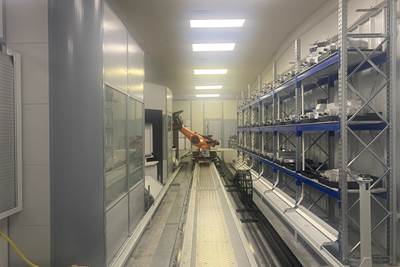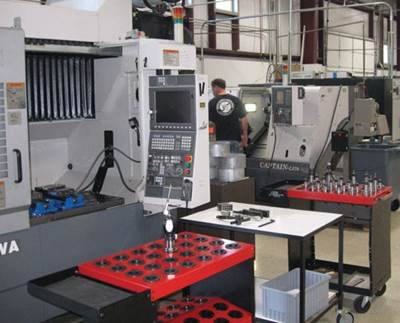Share





When it qualified as a Modern Machine Shop Top Shop in 2011, BDE Manufacturing Technologies (then known as Bob’s Design Engineering) was a prototyping shop just starting to move into production work. As of January 2023, this dynamic has shifted completely — second-generation owner Rick Hale says that 90% of jobs at the facility today are repeat production work, with 10% of work stemming from new customers.
A heavy investment in automated technology and automation-compatible machines has been key to this shift. Equally essential? BDE’s adaptable prototyping shop spirit and willingness to hire and train people for their mindset, not necessarily their prior experience.
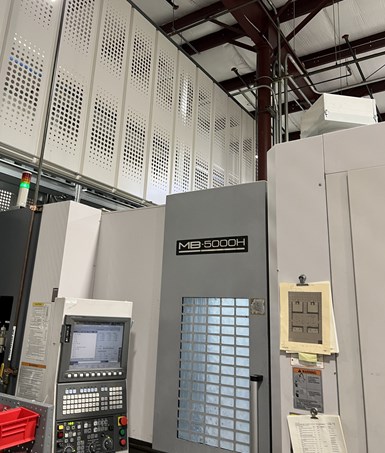
BDE’s 64-pallet Fastems flexible manufacturing system is currently connected to two Okuma four-axis mills. The shop plans to pair this automated system with a third, newer four-axis Okuma mill, but the process will require significant upgrades to the system.
Adaptable Automation
Automation has become central to BDE’s production operations. The company’s automated equipment includes a Mazak Integrex i100 multitasking machine with a bar feeder, a Mazak Nexus 250 MSY dual-spindle lathe with live tooling, an Okuma MA400 HA horizontal mill with a pallet changer, an Okuma MF-46 dual-pallet high-speed vertical machining center and a 64-pallet Fastems flexible manufacturing system.
The Fastems system is currently paired with two Okuma MB-5000H four-axis horizontal machines. Each machine has its own 326-tool hive, with tool management simplified via controls that can create preventative maintenance reports.
While this setup enables 24/6 automation, it has not been enough to handle the ever-increasing volume of orders. To help matters, BDE has purchased a third four-axis Okuma MB-5000H. Despite the same model name, this third machine is much newer than the original machines paired with the FMS — a 2018 machine rather than 2010 and 2011 machines — and boasts new software currently incompatible with the FMS’ controller. As such, the shop is using this newer machine standalone until Fastems can upgrade the FMS. Rick Hale says upgrading the cell will be an expensive endeavor, but the changes will be thorough.
While many of the updates will relate to the software running the FMS, Fastems will also change out some components from the original system which are no longer in production, simplifying any potential repairs.
The overall control system at the heart of the FMS (which Fastems calls the “operation plan”) sends pallets and their associated programs to the machines — these machines then adopt offsets stored in their controls. This system gives BDE flexibility in responding to changes in demand, as it can reassign pallets to jobs without much incident.
BDE cannot immediately rely on this process when part specifications change, however — a process that happens somewhat regularly. The shop’s largest customer, a conventional printer OEM, regularly updates its product lines and part specifications.
Hale estimates that the shop has thus far worked on half-a-dozen iterations of regular-sized printers and three versions of larger industrial printers. For each revision, the shop must prove out part designs once again and revise its programs for automation. In doing so, it relies on the prototyping expertise of its machinists — and on the capabilities of its prototyping corner.

BDE’s Okuma MF-46 vertical machining center may only be able to machine one face per operation, but the ability to load the pallet changer with blanks and run the machine lights out still increases its productivity compared to most vertical mills.
Prototyping and Pinch Hitting
BDE’s rapid prototyping department is home to the shop’s remaining manual mills and lathes, as well as several EDM machines, band saws and a three-axis bed mill. Here, the shop’s prototype machinists create test versions of parts before the designs are finalized and sent to production.
While this work gives BDE an edge for appealing to its customers, the workload is irregular enough that the department can’t justify its existence on prototyping work alone. It can do so, however, by also pitching in to fulfill small runs of components missing from large jobs’ bills of materials.
The importance of this task skyrocketed during the supply chain crisis caused by the COVID-19 pandemic. Even after several redesigns for component consolidation, the bills of materials for the printer bars that are BDE’s main part for its printer OEM client boast around 300 different components. BDE has traditionally made about half of these in-house, but the shop needs to outsource the other half, often from suppliers chosen by the OEM.
While the customer decided to wait on the PCA boards it needed from suppliers in East Asian countries, not all components were so specialized as to require that wait. Instead, BDE could turn to its rapid prototyping corner to produce these other components in-house. Prototype machinist Daniel Shaw says that even now, much of his job is machining parts to fulfill gaps in the supply chain.

BDE’s 5S (sort, set in order, shine, standardize and sustain) workplace philosophy not only helps the shop keep track of its hand tools, but helps with tracking its tooling use as well. The shop’s MSC Industrial Supply Co. tooling chest assigns part numbers to each tool, improving machinists’ ability to find what they need by referring to the setup sheet.
Transcribing Tribal Knowledge
BDE has been successfully adapting programs for part revisions and filling in supply chain gaps thanks to a major initiative to eliminate what operations manager Ryan Hale calls “tribal knowledge.” While process documentation had been extremely important to BDE in its prototyping days, the departure of a key process leader near the time the shop began transitioning to production disrupted its documentation policy. In 2019, the shop began reemphasizing formal process documentation, ensuring that improved process knowledge transferred through setup sheets.
This has both increased the shop’s agility by enabling machinists to run a wider variety of jobs faster and helped the shop train newer employees. Key to this transformation has been the shop’s programming staff, most of whom previously worked at shops with strong process documentation traditions, which they have adapted for use at BDE.
This increase in documentation is supported by the shop’s Global Shop Solutions ERP system. Dispatch lists developed through the software provide per-machine schedules of upcoming jobs, which management updates every Monday to account for any urgent changes. Ryan Hale also credits the system with simplifying parts quoting and says the shop uses it to generate work orders, complete with tool and material lists.
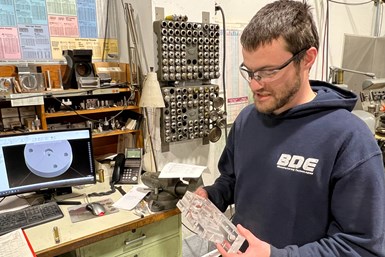
In addition to shifting its hiring strategy, BDE has overhauled its benefits to retain its current staff. One notable benefit is the shop’s healthcare coverage, as BDE pays 100% of its employees’ medical, dental and vision premiums, as well as 50% of those for dependents. For employees on spouses’ medical plans or young enough to qualify for their parents’ plans, the company provides them 50% of the cost of premiums as a discretionary “medical benefit.”
Beyond Button Pushing
Thorough process documentation has also served BDE’s hiring efforts. As the shop is facing the same shortage of trained applicants as most manufacturers across the country, it has taken to both hiring mechanically inclined new folks and offering opportunities for people in other departments to retrain as machinists. Rick Hale says new employees are only button pushers for the duration of training as they learn on the job, shadowing departments and consulting experienced employees.
Ryan Hale says the goal is to familiarize these greenhorns with the setup sheet and tool list until they are ready to set up tools and vises themselves. Then, the shop encourages them to progress to more challenging aspects of machining.
Gradually ramping up responsibilities for machinists has not only attracted people fresh to the field, but has also won over employees from other shops — Hale points to the example of one employee whose previous employer assigned him strictly as a parts loader, with no opportunity to grow or progress. Hale says this employee has swiftly learned the basics of machining and excels on the shop floor, a prime example of BDE’s willingness to adapt leading to better outcomes for its bottom line and — perhaps more importantly — its people.
Related Content
Fryer’s Horizontal Boring Mill Designed for Ease of Use
The HB Series Boring Mills feature rugged cast iron bodies and high-precision ballscrews and bearings to ensure high-accuracy tolerances.
Read MoreHorizontal High-Speed Machining Saves Hundreds of Work Hours
High-speed machining is the latest change at Blair-HSM South, helping this once old-fashioned shop improve productivity and morale while enabling new work.
Read MoreFryer Offers Compact HMC for Small-Lot Machining
The Fryer HR-40 features a built-in 24" rotary table for multi-sided machining.
Read MoreJTEKT Launches New Series of HMCs
The new FH5000 series machines include a 500-mm table capable of handling 1,000-kg loads.
Read MoreRead Next
Benchmarking: An Invaluable Business Tool
Modern Machine Shop’s Top Shops program shows shops their strengths and opportunities for improvement, and provides recognition for high-performing businesses.
Read MorePreparing a Shop for Automation
Ensuring a stable, predictable production process can prevent automation from multiplying existing problems.
Read MoreWhen Reshoring Really Happens
Bob’s Design Engineering illustrates how a shop that used to be organized for short-run work transformed its process for ongoing production.
Read More

























